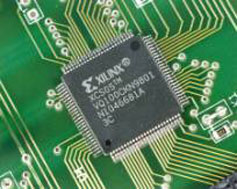Neutron Research & Atmospheric Radiation Effects on Aircraft Electronics

KVA Engineering utilizes a 14 MeV neutron generator for the purpose of conducting various studies in material sciences and electronics. Neutrons offer significant capabilities in understanding the structure and properties of materials that are unmatched by other investigative techniques. Neutrons can penetrate deep within materials - from steel to concrete to ice - to reveal their structure at the atomic scale. This technique - called neutron scattering - helps industry to answer questions that can't be addressed in any other way.
More than ever neutron sources are used to understand and "engineer" materials at the atomic level. Such materials have greatly improved properties, offering both better performance and new applications. For example, things like jets, credit cards, pocket calculators, and compact discs have all been improved by neutron-scattering research.
Single Event Effects - During the last 20 years, it has become evident that electronics in airplanes suffer effects from cosmic-ray induced neutrons. In just the last few years the evolution of electronics has produced devices that are even more sensitive to these effects resulting in significant design and safety issues. For instance, a neutron can induce a nuclear reaction in the silicon substrate of a memory device, releasing free charge, which flips one or several memory units. This phenomenon is often referred to as single-event upset (SEU), a special case of single-event effects (SEE). Similar effects causing soft- and/or hardware damage have recently been identified at ground level as well. To evaluate these effects in electronics and obtain statistically meaningful data accelerated testing is used. The 14 MeV neutron source that KVA uses has sufficient beam intensity to provide a time acceleration factor as high as 10 E6. (i.e. one hour in the beam is equal to a million hours in service.)
The neutron generator is configured into five different beam lines that can function simultaneously allowing multiple experiments to be conducted at the same time.
| Line Number | Beam Type | Range of Particle Fluence |
|---|---|---|
| 1 | 1" round Beam - Used for singular part SEU testing | *10E7 neutrons per second per square centimeter or less |
| 2 | 3" round Beam - Used for multiple part SEU testing | *10E7 neutrons per second per square centimeter or less |
| 3 | 1" or 3" Beam with thermal and 14 MeV neutrons | *10E7 neutrons per second per square centimeter or less |
| 4 | No collimation - Used for whole board or LRU SEU testing | *10E8 neutrons per second per square centimeter or less |
| 5 | Pulsed beam used for material reasearch | *10E8 neutrons per second per square centimeter or less |
| *Fluence can be adjusted at the neutron source by adjusting the power or by increasing or decreasing the distance between the item under test and the neutron source. | ||
KVA is developing cooperative agreements with two Michigan universities to share this research tool. This arrangement will increase the research capabilities of this facility providing increased access by industry users and educational researchers.
For technical questions regarding the use of this facility contact Ken Vranish at 616-745-7483 or email kvranish@kva-engineering.com.
For questions related to scheduling beam time, contact Valerie at 616-401-0435 or email to Valtech@kva-engineering.com.

